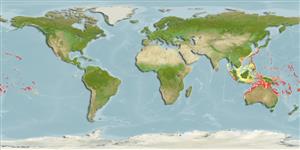Common names from other countries
Environment: milieu / climate zone / depth range / distribution range
Ecology
Marine; reef-associated; non-migratory; depth range 0 - 50 m (Ref. 30874). Tropical; 24°C - 28°C; 35°N - 31°S
Western Central Pacific.
Size / Weight / Age
Maturity: Lm ? range ? - ? cm
Max length : 14.0 cm TL male/unsexed; (Ref. 9710); max. reported age: 11 years (Ref. 72479)
Adults occur in coral rich areas of shallow lagoon and exposed seaward reefs from the lower surge zone (Ref. 9710) to 50 m (Ref. 30874). Benthopelagic (Ref. 58302). Juveniles secretive (Ref. 9710). Feed mainly on algae. Live as long as 11 years in captivity (Ref. 37816). Frequently exported through the aquarium trade (Ref. 48391). Minimum depth reported taken from Ref. 128797.
Life cycle and mating behavior
Maturity | Reproduction | Spawning | Eggs | Fecundity | Larvae
Bi-directional sex change has been confirmed for this species (Ref. 103751).
Pyle, R., 2001. Pomacanthidae: Angelfishes. p. 3266-3286. In K.E. Carpenter and V.H. Niem (eds.) FAO species identification guide for fishery purposes. The living marine resources of the Western Central Pacific. Volume 5. Bony fishes part 3 (Menidae to Pomacentridae). Rome, FAO. (Ref. 48391)
IUCN Red List Status (Ref. 130435)
CITES (Ref. 128078)
Not Evaluated
Threat to humans
Harmless
Human uses
Fisheries: subsistence fisheries; aquarium: commercial
More information
ReferencesAquacultureAquaculture profileStrainsGeneticsElectrophoresesHeritabilityDiseasesProcessingMass conversion
Tools
Special reports
Download XML
Internet sources
Estimates based on models
Preferred temperature (Ref.
115969): 25.6 - 28.8, mean 27.5 (based on 218 cells).
Phylogenetic diversity index (Ref.
82804): PD
50 = 0.5000 [Uniqueness, from 0.5 = low to 2.0 = high].
Bayesian length-weight: a=0.02951 (0.01513 - 0.05755), b=2.92 (2.75 - 3.09), in cm Total Length, based on LWR estimates for this species & (Sub)family-body (Ref.
93245).
Trophic level (Ref.
69278): 2.8 ±0.33 se; based on food items.
Resilience (Ref.
120179): Medium, minimum population doubling time 1.4 - 4.4 years (Preliminary K or Fecundity.).
Fishing Vulnerability (Ref.
59153): Low vulnerability (10 of 100).
